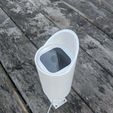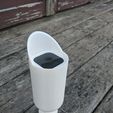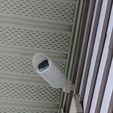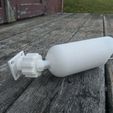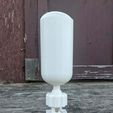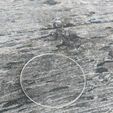This is an Outdoor Enclosure for Amazon's Blink Mini security camera. The little cameras can be purchased extremely cheaply when on promotion but are for indoor use only. With this 3D Printed enclosure, you are able to mount it outside and have an outdoor security camera for a fraction of the price of most anything on the market.
###Notes:
###--The Acrylic--
- There is a recessed area around the camera to add a 2 3/8" diameter x 1/16" thick piece of acrylic.
- To cut this acrylic, I used a standard hole saw bit on a drill. I suggest drilling a hole through a piece of wood first, removing the centre drill bit, then sandwiching the acrylic between the wood piece with the hole and another wood piece to help you accurately line up your cut.
- Drill slowly and use a lubricant like water if possible to help dissipate the heat. It will crack if it heats, then cools down quickly.
- When attaching to the front of the camera enslosure, DO NOT USE Wax/Heat (see Waterproofing notes) or Superglue. I suggest using silicone or caulking.
###--Water Proofing---
- I suggest using wax to make the enclosure waterproof. 3D prints can look water tight, but be surprisingly porous.
- Paraffin Wax can be purchased many places inexpensively for Canning Food, or Candle making.
- Rub it all over the outside of the enclosure, then using a hair dryer, slowly work the hot air around the wax until you see it start to melt. The wax WILL melt before PLA but don't hold the heat in one place for too long as it will deform the plastic or worse. An effective technique is to start melting the wax in one area just a little bit, let it cool and then apply more heat to remelt it and smooth it out.
- I do not suggest adding wax to the inside of the enclosure because the tolerances are very tight for the camera and it will likely warp the inner walls. It is better to have the camera in place while completing this step.
- I suggest avoiding hitting the acrylic with heat as well because it will probably start cracking.
- You may want to stick a Silica Gel packet (used for shipping products) or some kind of desiccant behind the camera to help absorb stray moisture.
##--Installing--
- Once you plug in the Micro USB cable and slide the camera in (I bought a 10 foot Micro USB cable from a local store to have extra length to play with), install the screw in ball mount, then fill the ball part of the mount with something like silicone or caulking so that the cable cannot be easily pulled back out and to increase water resistance. If you pull the cable out of the camera after this step, you're going to have a bad day.
- Use four long wood screws to attach to your surface of choice.
##IMPORTANT NOTE # 1
The acrylic on the front of the camera will cause the IR (Infrared) Light to reflect back into the camera lens and you will not see much at night time. Turning off Night Mode is a surprisingly good option if you have street lights or keep your porch light on, but for those who want to use Night Vision, I suggest you block off the IR Light with something opaque (like electrical tape) before installing the acrylic and use an external IR Light source. Alternatively, you could carefully drill a hole in the acrylic where the IR Light will be situated and try to seal around it with clear silicone against the camera, but remember this camera is designed for indoor use and the light may not be strong enough for a large area.
##IMPORTANT NOTE # 2
The tolerances on the hole for the camera is very tight by design to maximize water resistance. This may cause an issue on different print settings, temperatures, cooling speed, etc etc. If your camera does not fit after you have printed the enclosure, heat the inside slightly with a hair dryer on the low setting for about 10-20 seconds while moving it around. Once slightly warm (it doesn't take much, try to work the camera into the hole and let the plastic cool with it in place. DO NOT GET THE INSIDE TOO HOT OR IT WILL WARP.
##If you use this print, improve upon the design of this enclosure or are inspired to create your own Blink Mini enclosure, I would love to know!

/https://fbi.cults3d.com/uploaders/16713531/illustration-file/6412f1d6-a156-4016-b888-fdfcc94ebfa3/Camera_5.jpg)
